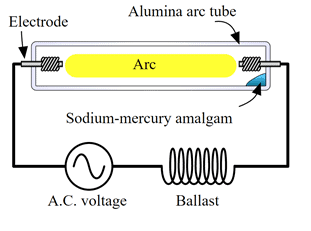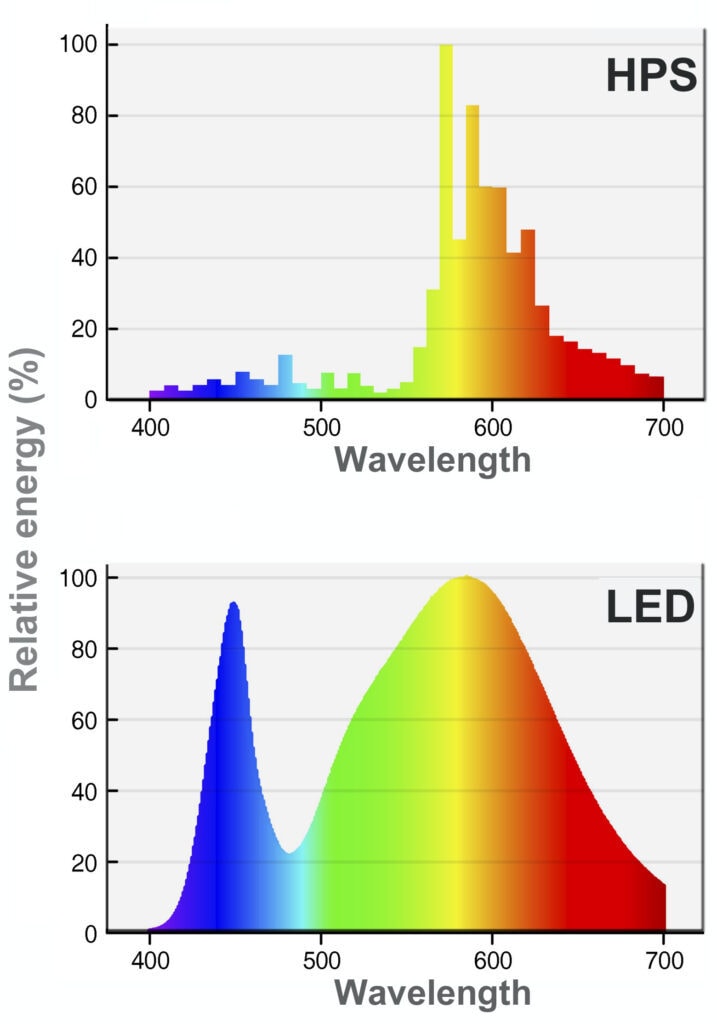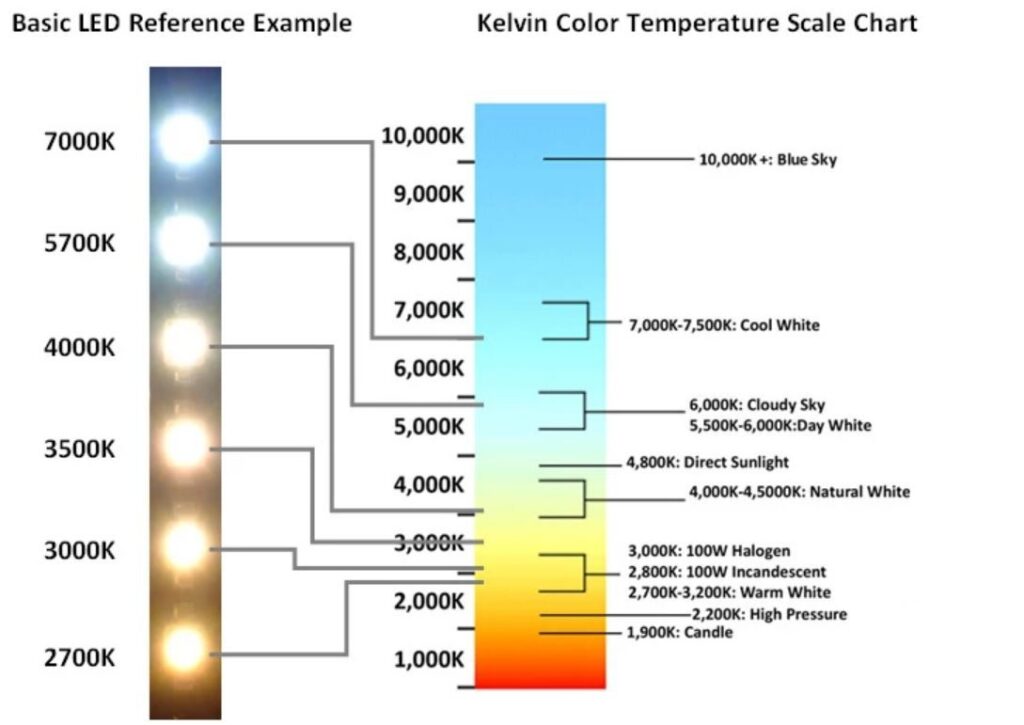All About High-Pressure Sodium Lights
The popularity of High-Pressure Sodium Vapor (HPS) Lights spiked when the concept of grow lights came into being. They have been used in horticulture as HPS lamps emit light rich in the red spectrum that promotes plant growth and flowering. Since then, technology has evolved, and there are many more efficient options. But what are they, and can you use them in your project? Let’s find out.
What are High-Pressure Sodium Lights?
HPS and LPS (Low-Pressure Sodium) Lamps belong to the family of Gas Discharge Lamps. These lamps generate light energy by sending an electrical discharge through an ionized gas (e.g., argon, neon, krypton, etc.). The electrical discharge excites the atoms in the plasma, generating ions that move towards respective electrodes and interact with other particles. The whole phenomenon generates artificial light energy, the color of which depends on the emission spectra of the gas in the bulb.
The main difference between HPS and LPS is, just as the name implies, the operating pressure inside the tubes is different. HPS uses vaporized sodium metal and other elements, such as mercury, to balance the output color temperature. A high-pressure sodium arc is contained in an aluminum oxide arc tube because the sodium arc is highly reactive. On the other hand, LPS consists of a borosilicate glass arc tube.

Output Color Properties of HPS
Before heading to the pros and cons, let’s look at what color temperature range HPS light falls into. The standard HPS output lies between 1900 to 2000 degrees Kelvin. This corresponds to a distinctive yellow color. HPS lights have a color rendering index (CRI) ranging from 20-22. They show the right primary colors but are unsuitable for greens, blues, and violet. Nowadays, color-corrected HPS lights are in use because they offer higher CRI of up to 80 and a color temperature range of 2600-2700K compared to standard HPS lights. The output of such HPS lights is similar to that of incandescent bulbs.

Advantages Of HPS Lights
Coming to the part you’ve most certainly been waiting for; the benefits of HPS lamps. HPS lamps have a lot to offer, which is why they are widely used in specific industries.
- Regarding efficiency, HPS Lamps are better than incandescent and mercury lamps. These lamps are approximately seven times as efficient as a regular incandescent lamp and about three times as efficient as a metal halide or a mercury vapor lamp.
- If we talk about efficacy (the efficiency of a lamp to convert electricity into light that is useful for photosynthesis), HPS is not very far in competition with LEDs. However, HPS emits a broad spectral output light, most of which is rendered useless for plants. LEDs, on the contrary, are much more efficient in this sense, as their output can be optimized to emit only valuable wavelengths.
- With most HPS lamps, the average warmup time spans about 4-6 minutes. Compared to mercury halides and incandescent lamps, HPS requires much less time to reach its peak output state.
- HPS lamps have a good and long life of 24,000 hours.
- These lights have excellent lumen maintenance. They can easily maintain their luminance for 90% of their life and still emit 80% at the end of their life.
Disadvantages Of HPS Lights
HPS lights are now slowly being replaced with the newest technologies, and LED lights are currently on the top. Here are some significant disadvantages of HPS lights that make them less preferable.
- In color rendering, HPS lights are surpassed by many other technologies. So it is best to use such lamps where color rendering is not a significant concern.
- Another disadvantage is its warmup time. After the ignition of the arc, the metal salts are vaporized. The output light doesn’t reach its peak intensity until all the salt is evaporated. The light gradually transitions from red to a distinctive yellow color.
- The world is now eradicating the use of toxic and hazardous materials and striving towards a green future. HPS contains small amounts of mercury which is harmful to the environment if released from the tubes. You can not dispose of HPS lights for this reason.
- HPS lights throw light in a 360° direction, which means that approximately 15% of the light goes to waste, rendering this solution inefficient.
- One another disadvantage is that HPS lamps are susceptible to flickering and damage. This increases the maintenance cost and the overall cost.
- HPS lights require ‘ballast’ for a stable operation that supplies a constant current to the fixture. This ballast can be damaged by a continuous process and need immediate replacement.
Applications of HPS lights
Since these lights have the upper hand in efficiency compared to incandescent bulbs and fluorescent and mercury lamps, they are used in energy-efficient applications.
- High-pressure sodium bulbs are used in parking lots, streetlights, and indoor settings where CRI is not a big issue.
- HPS lamps can provide high-intensity lighting, which is why they are widely used in warehouses, industrial areas, and shipment regions where fixtures are hanging high above the ground (~15 feet or more).
- The yellow color restricts the applications of HPS lights to only street lights and outdoor projects.
One another thing to consider is the wattage of HPS lamps, as the output lumen depends on the wattage. The wattage depends on supply voltage, ballast, and fixture design. HPS lights are still widely used, although they are slowly being replaced by LED lighting.
Special Tips: We advise you not to use HPS lights in applications where lighting precision is required, such as facades, task applications, tourism spots, etc. The color rendering is low, which reduces the visibility at night. To cater to this problem, some designers and manufacturers have created color-corrected HPS lamps that can go up to CRI 80. Moreover, do not use such lights in places where lights must be frequently switched on and off since HPS lights have long warmup and re-strike times.

All About LED Lights
Now, you may know about the strengths and weaknesses of HPS lights if you have read the last part. Here we will look at another famous light source, i.e., LED lights.
LED lights have revolutionized exterior decor. All the significant decorations are done using these low-power and high-output LED lights. They have replaced incandescent lights completely, especially since the world is opting for environment-friendly options. These LED lights are greener and more efficient than any other light source. Almost all residential use and commercial sector has adopted LEDs. They may cost more initially, but their long-term usage is much more beneficial.
Before exploring why you should buy these fantastic and long-lasting lights, let’s find out what these are in the first place.
What is LED?
To understand the power of LEDs, you need to know what they are made of. This may sound a little boring, but we will simplify it for you.
LED is short for Light Emitting Diode. Like HPS, it has two electrodes (cathode and anode) through which the current passes. These electrodes are silicon and selenium semiconductors. There are two types of these semiconductors present. One has positively charged holes, and the other negatively charged electrons. When you switch the LED, the electricity flows from the anode to the cathode. This results in the interaction between two semiconductors. This reaction of positive holes and negative electrons produces energy that is seen in visible light.
With a bit of tweaking in semiconductors and introducing different systems of diodes, other colors can be produced. The indium gallium nitride (InGaN) system creates Cyan, blue, and green colors. LED’s come in a wide variety of colors and intensities, and that is a significant plus point. This increases the application manifolds. That is the beauty of LED, and this wide variation is why they dominate the world now.
Output Properties of LEDs
LEDs, unlike HPS lamps, offer a wide range of color temperatures. This increases their applications and broadens the dynamics of possible results that can be achieved. Using the right color temperature, you can create a certain ambiance and mood for your outdoor or facade lighting project. LEDs can give output in the range of 2700K-6500K, from warm light to daylight.

Advantages of LED Lights
Here we are going to discuss the pros of LED lights. This may help you make up your mind about what to buy for your own home or business.
- The light quality is fantastic. There are a vast number of shades and different colors available. They are great for decoration as they are pleasing to the eye.
- They require low maintenance. The circuits are durable, and the plastic they are made from is long-lasting, cost-effective, and hassle-free.
- LEDs outrun every other light source in terms of longevity. Their life span can be up to 50k hours to 100k hours or even more. Every different light can remain functional for up to 20 to 30% of the time.
- They are green and environment-friendly. LEDs consume less power overall and emit a very trace amount of infrared light.
- Consuming less power affects electricity consumption, saving you a lot on your bills.
- LEDs are easy to repair. They have cheap components that can be replaced and fixed readily.
- Various sizes are another feature, as LEDs come in all shapes and sizes. No other light source can be this versatile.
- LEDs have a quick startup time.
- The lights are directional and illuminate the area equally and adequately.
Disadvantages of LEDs
- With so many advantages, you may wonder if there are any cons to LEDs, and you are right; there are not many disadvantages to these.
- The primary thing that poses a problem is their initial cost. The LEDs have been expensive since their arrival. Their cost-effectiveness comes after prolonged use.
- The upfront cost would concern the business owner, but the pros outweigh the cons at any time. As technology advances, this issue may resolve sooner than you might think.
Learn more about the Advantages and Disadvantages of LED Lighting.
Uses of LED lights
When we say LED lights are the most versatile light source globally, we mean it. LED technology has completely changed the light industry. The expansion of its use owes to its flexibility.
Let us explore the excellent application of LEDs, making them perfect for residential use and ideal for business.
- Computers and electrical appliances have been the first to use the excellent functionalities of LEDs light. Initially, they were confined to circuit boards, but slowly their applications widened.
From traffic lights to smartwatches, they are everywhere.
- LEDs are popular for large areas, big halls, and gymnasiums. They have replaced incandescent and fluorescent lights. The output is on par with fluorescent lights, but power consumption is far lower.
- Façade and architecture lighting is another primary use of LEDs. These lights give the mundane wall a very artistic look. LEDs have entirely altered the art of exterior decor these days.
These LEDs give an aesthetic look, and designers have plenty of room to play around.
- Art galleries also showcase an incredible display of LED lights.
- They are instrumental as Grow Lights. LED grow lights are being used right now for nurturing plants indoors.
- LEDs have significantly influenced the automotive industry. From LED work lights to tractor lights, cars are using LEDs everywhere.
This is similar to the aerospace and maritime industry. From signals to electronic devices, their applications are varied.
- Perhaps the most influential application is a LED screen. This technology forever changes the television and the display screens. The size of screens is reduced significantly as well as their cost.
- LEDs are best for landscape lighting. They are much safer than fluorescent and incandescent lights.
Since they produce less heat, they are environmentally friendly, and landscapes are often lit all night, making them a reliable and safe option.
- LEDs can tackle harsh outdoor environments. They are made from a sturdier material that lasts longer in wind and rain. They are resistant to breakage, previously a problem with glass lights.
Comparison Chart
We have summarized all the features (mentioned above in detail) in the chart below.
| Features | LEDs | HPS Lamps | Winner |
| Color Rendering Index (CRI) | LEDs have the best CRI on the market (>70) | Standard HPS Lights have low CRI (20-25) | LED |
| Warmup time | LEDs have a quick startup time | HPS requires about 5-10 minutes of warmup to reach its total output. This limits its applications. | LED |
| Color Temperature Range | LEDs offer a wide range of color temperatures, from cool colors to warm temperatures (~2700-6000K) | HPS lights have a characteristic yellow color that limits their applications (~1900-2200K) | LED |
| Life and durability | LEDs have more extended life than any other lighting, up to 50000+ hrs. LEDs require minimum maintenance. | Although HPS lamps have a relatively long life of about 25000 hours, it is still not comparable to LEDs. HPS lights are not highly reliable. | LED |
| Eco-friendliness | LEDs are not made of any toxic material and are highly eco-friendly and safe. | HPS lights have small amounts of mercury in them, making them hazardous to the environment. | LED |
| Efficiency | LEDs are a highly energy-efficient and cost-saving solution. According to research, they can save up to 348 TWh by 2027. | HPS are omnidirectional, which lets them lose approximately 15% of their energy. | LED |
Conclusion
Businesses are all about investing in the right place. LEDs have a higher initial cost than HPS lights, but considering the long-term advantages, we suggest you go for an LED lighting solution. LEDs offer a more comprehensive range of output colors, functionality, and dynamic results. Moreover, they are eco-friendly and require minimum maintenance.
RC Lighting is a LED landscape lighting and LED facade lighting manufacturer in China. We provide a one-stop solution for your projects. Contact us to get a quote for your upcoming projects now!




